#margaret pie
Explore tagged Tumblr posts
Text


Magpie dump! Honestly I'm really proud of the design for this one!
32 notes
·
View notes
Text
Some colored sketches of dc characters I did several months ago


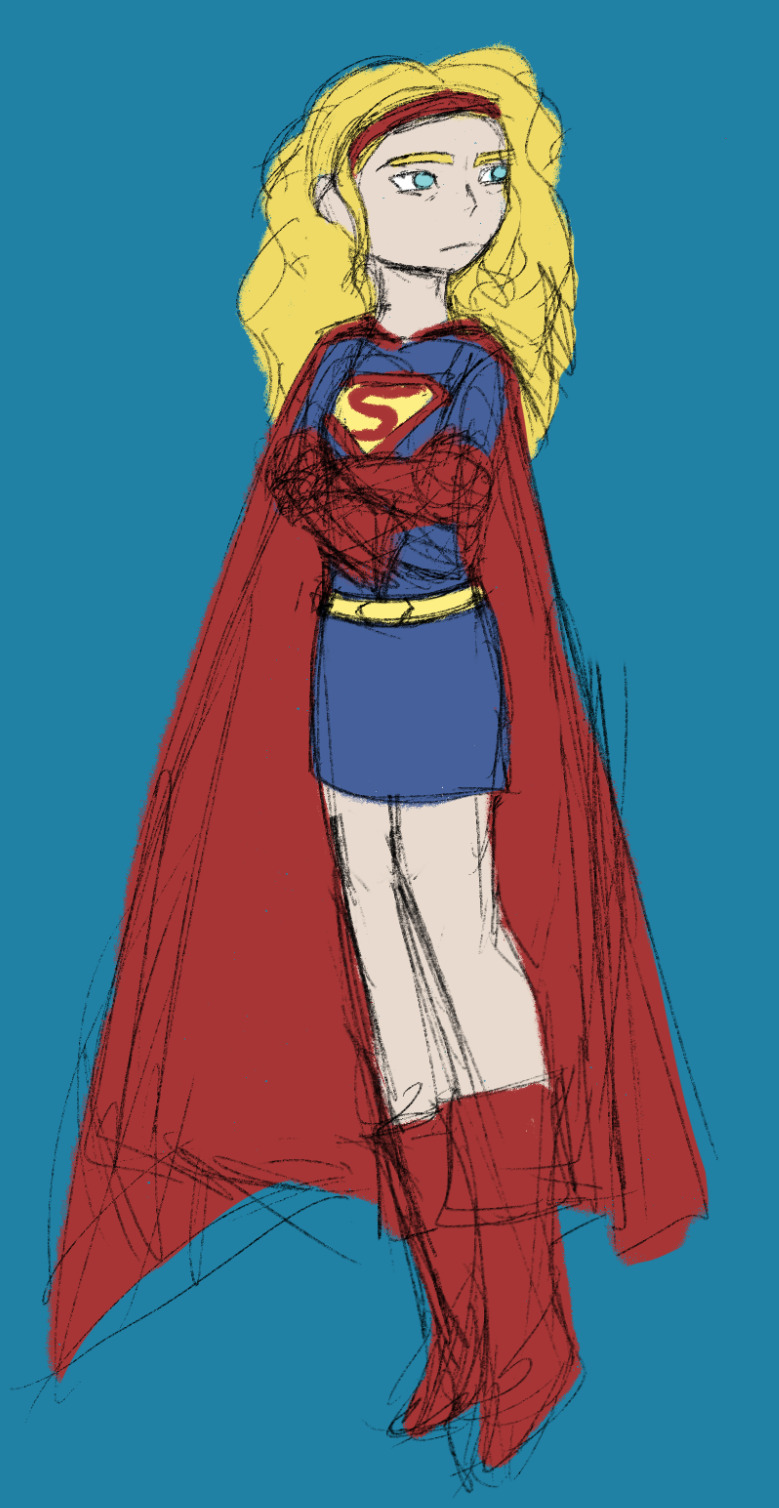
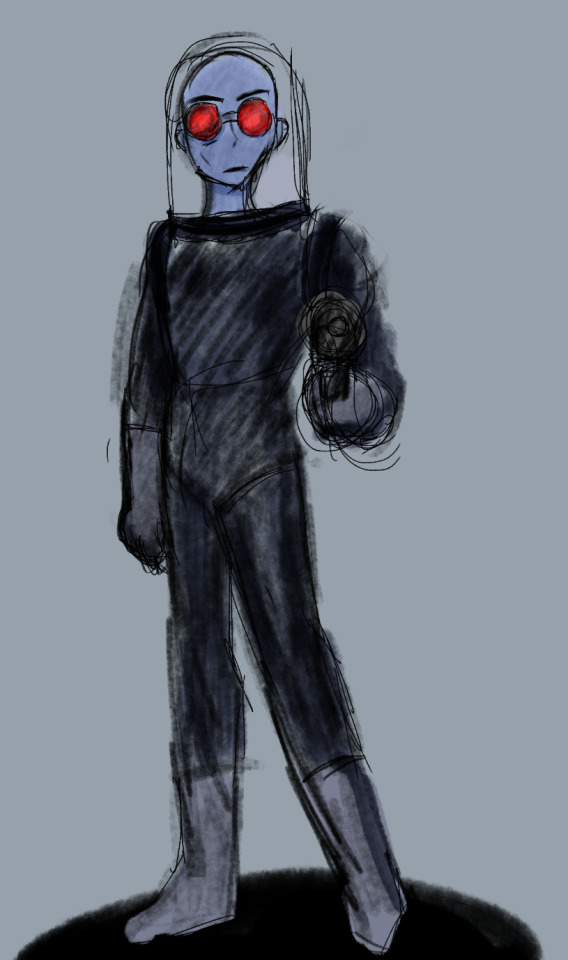
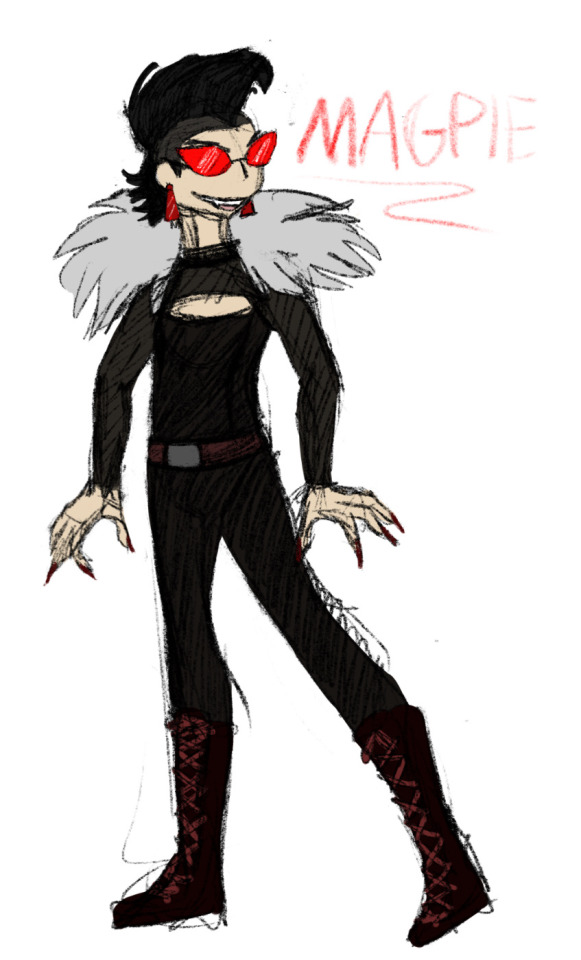
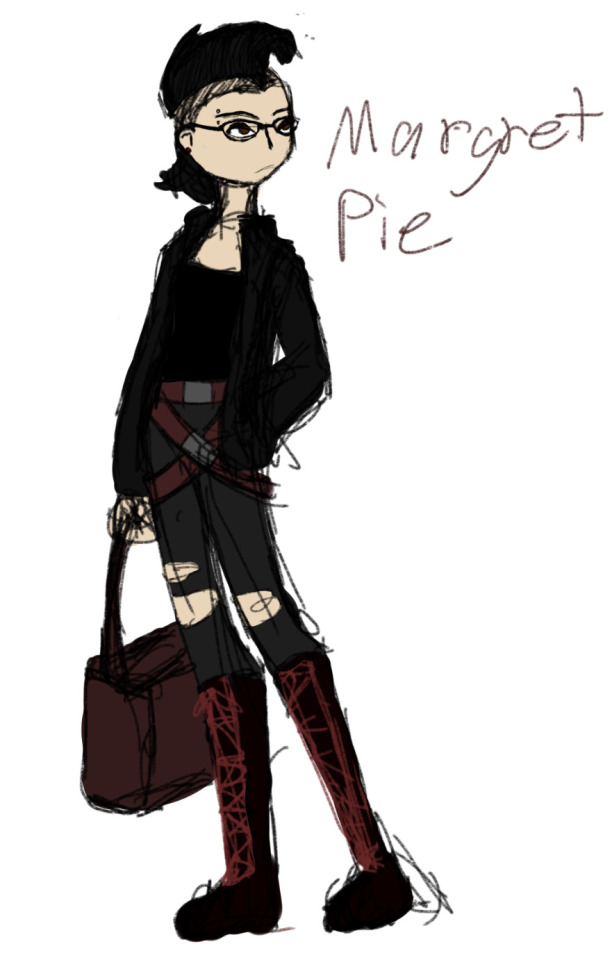
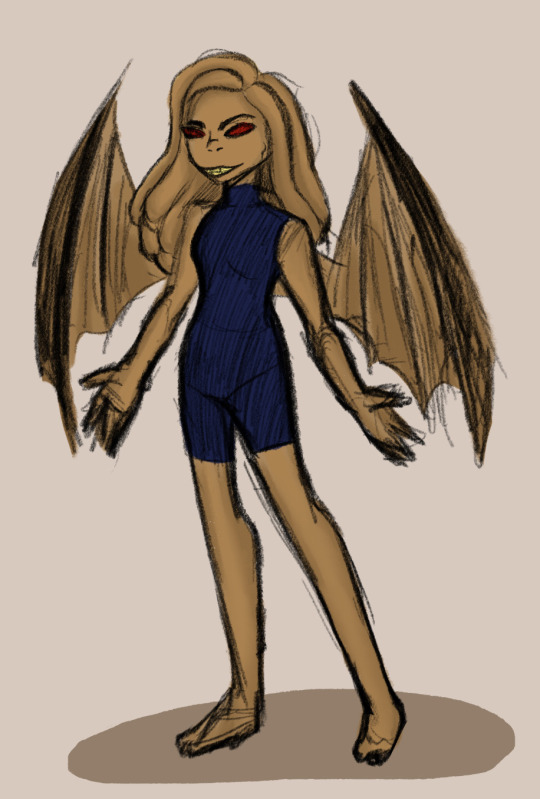
#edward nigma#Edward nigma fanart#mr freeze#lady clayface#super girl#batgirl#magpie#magpie dc comics#Margaret pie
7 notes
·
View notes
Text
It's interesting to me that when people are feeling particularly vicious and biting, they always go after Beej. Like, the venom I will see spat at him specifically is just remarkable.
#hawkeye spent entire seasons sexually harassing and bordering on sexually assaulting women and bj hit hawk once#trapper and bj both have violently knocked hawkeye clean off his feet the same amount of times while equally drunk#mulcahy makes it perfectly clear that he would like to hit hawkeye and uses his faith as the last remaining reason why he does not#trapper spends almost his whole time at camp insulting his wife and bj breaks down over his a handful of times#imo margaret and hawkeye and bj are all pretty much tied for the amount of character development they go through in the show#but because bj evolves in challenging ways instead of being a perfect apple pie eating bright white teethed sidekick#he is treated with such a remarkable amount of virulence that i will never understand#i do so much to try and make myself open for all kinds of people to enjoy the content i write#but i do have really painful moments where i have to look in the mirror and seriously ask myself#why i want so badly to be liked by people who would gleefully stab my favorite character a thousand times while i watched#my ramblings
13 notes
·
View notes
Text
i think it's overall a good trend that more books are including content warnings in them but 2 trends within that i've noticed lately that drive me crazy are 1. when the book says to visit the author's website for further details since how do you know that url is still going to be functioning in 10 years, maybe just spend an extra sentence or two to include all the relevant information and 2. when the content warnings are weirdly elaborate and trying to be funny (ex: including things like "bad things happening to people named kyle" a real content warning in a book i saw yesterday) rather than just being straightforward and to the point
#i feel like a lot of sort of comedic dark romance novels that are popular lately do the funny content warning things and it drives me NUTS#just say 'descriptions of graphic violence' and leave it at that#there ARE authors who do a good job with content warnings i like how margaret owen does hers for the little thieves books#anyway i was just thinking about this earlier#pie says stuff#books
11 notes
·
View notes
Text
the reason i know time travel will never be invented in my lifetime is a million of me would have shown up to give early transition ali different name change ideas
7 notes
·
View notes
Text
Shoujo Manga's Golden Decade (Part 3)
Shoujo manga, comics for girls, played a pivotal role in shaping Japanese girls’ culture, and its dynamic evolution mirrors the prevailing trends and aspirations of the era. For many, this genre peaked in the 1970s. But why?
Part 1
Part 2
Follow the Trend
Before we move on to the third movement of the '70s, let's take a quick look at an essential characteristic of shoujo manga: its sensitivity to trends.
The early '70s were a confusing time for the industry. There was extreme freedom in certain corners, with Yukari Ichijo, Machiko Satonaka, and other prominent artists drawing very adult-like drama in shoujo magazines for very young girls. In contrast, there was also a lot of moralism. The fact manga wasn't taken very seriously meant magazines could get away with a lot since adults considered them terrible influences anyway. But, at the same time, since manga wasn't a respected medium, they were also prone to hysteria. Nothing illustrates this scenario better than the controversies surrounding "Harenchi Gakuen," the first full-length series by Go Nagai, who went on to become one of the most celebrated manga artists of the '70s.


Shameless! The nudity and erotic jokes in Go Nagai''s "Harenchi Gakuen" were a hit with kids and teens, scandalized parents and teachers, and made the shoujo industry chase after their own erotic hits.
Nagai, already a respected yet fledgling name in the industry, was recruited by Shueisha to be part of Shonen Jump's inaugural team in the late '60s. Jump, as any manga fan knows, is by far the biggest success story in manga's editorial history. However, back then, it was just a newcomer in a field dominated by Kodansha's Weekly Shonen Magazine and Shogakukan's Shonen Sunday. Go Nagai's series, whose translated name meant "Shameless High School," is Jump's initial smash hit and one of the titles behind its extraordinary ascent.
But "Harenchi Gakuen," a gag manga with erotic jokes, scandalized adults across the nation. The Japanese Parents and Teachers Association successfully led a Shonen Jump boycott, getting the magazine banned in several shops across the country and triggering a media circus. At the time, agitated journalists often accosted Go Nagai at airports and public events, aggressively pointing their mics at him, a consequence of manga-kas celebrity-like notoriety during that era.
Meanwhile, the reaction around "Harenchi Gakuen" did not intimidate other manga magazines. In fact, all of them were pursuing their own "harenchi"-like phenomenon and publishing stories with erotic dirty jokes. And yes, that included the manga magazines for little girls. In Ribon, male manga-ka Hikaru Yuzuki was responsible for the "dirty" manga series. At Weekly Margaret, Yuzuki also had a considerable hit with the high school comedy "Elite Kyousoukyoku," which, while not precisely "ecchi," had a tone reminiscent of Nagai's work. At Nakayoshi, the artist in charge of this type of content was none other than a pre-"Candy Candy" Yumiko Igarashi.
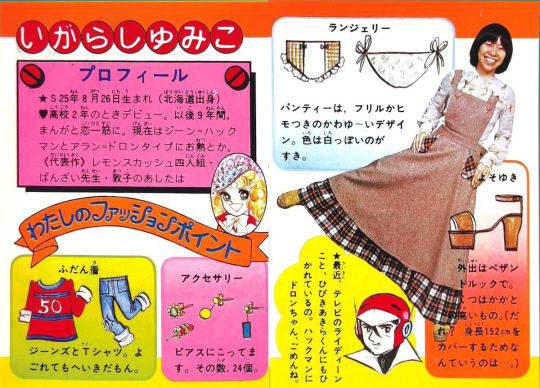
Before finding success with the smash hit "Candy Candy" manga, Yumiko Igarashi was the Nakayoshi artist in charge of recreating the "harenchi" phenomenon in the pages of the magazine. Above, in a good display of how public manga artists were in the '70s, Yumiko describes her panties as part of a Nakayoshi feature.
The "harenchi" phenomenon hinted at a shoujo field that wasn't yet wholly solidified and, therefore, was taking cues straight from the shonen segment, which would later become uncommon. But it also illustrates how the genre projects readers' dreams and preferences.
An example of this is one of Ribon's most popular series during the '70s, Yukko Yamamoto's "Miki to Apple Pie." Serialized between 1973 and 1976, this gag high school manga was full of absurd humor and nudity in the "Harenchi" vein. The twist is that it also had everything girls dreamed of.
The "apple pie" in the title was a reference to the lead character's favorite dessert during the time the American apple pie had just arrived in Japan and was considered the trendiest sweet. Miki Miyazawa, a popular and beautiful girl who served as the proxy for readers and was loosely modeled after talento Aki Aizawa, also loved astrology and the horoscope, and the romantic lead was a transfer student named Hideki Nanjo, who was a carbon copy of Hideki Saijo, the biggest popstar heartthrob of the '70s. Basically, "Miki to Apple Pie"'s central premise was "What if the popstars girls go crazy for was your silly gorgeous classmate?".
In fact, a testament to Saijo's popularity was how many shoujo manga romantic partners of the era used him as a model. Besides "Miki to Apple Pie," inserts of him were present in Satonaka Machiko's "Spotlight," Shigeko Maehara's "Kimi Iro no Hibi," Mayumi Yoshida's "Lemon Hakusho," among others.

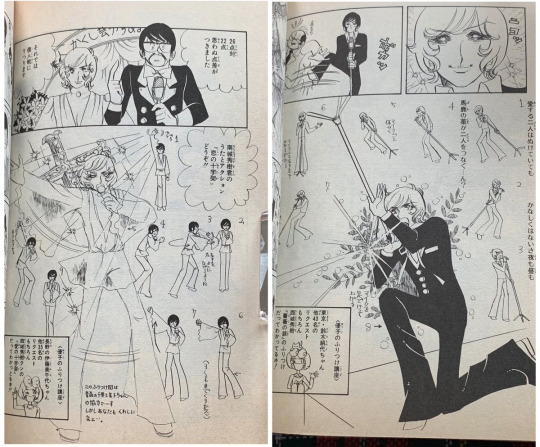
With nudity, slapstick humor, and numerous references to trends and pop culture, "Miki to Apple Pie" became a sensation in the pages of '70s Ribon. The romantic lead, Hideki Nanjo, modeled after heartthrob Hideki Saiji, frequently performed impromptu renditions of popular hits from stars like Agnes Chan, Finger Five, Momoe Yamaguchi, Junko Sakurada, and, of course, Hideki Saiji himself. Full of shockingly offensive and scatological jokes, very little was considered off-limits, making "Miki to Apple Pie" a quintessential example of the distinctive '70s shoujo manga published during the peak of the "Harenchi" boom. It also serves as a perfect time capsule of its era, satirizing and commenting on everything popular at the time—from iconic products like the Panasonic Quintrix television and memorable TV commercials to celebrities, the toilet paper shortage during the Oil Shock, the Discover Japan campaign, and the widespread teenage girls' fascination with horoscopes. This manga elevated shoujo manga's trend obsession to unprecedented heights and mixed it with absurdity.
Saijo is a relic of the past, but shoujo echoing the trends of its time is a timeless characteristic of the genre. That's why most shoujo artists are women who are close in age to their readers: this sensibility to girls' desires is a vital component of the market. From the way the characters look to how they dress to even the shape of their eyebrows, everything is supposed to reflect its time. Therefore, to successfully create shoujo, one has to understand how girls perceive themselves and also how they want to be perceived. How they dress and look, but also how and what they dream of looking and wearing. What they aspire to and, above all, what they find attractive in the opposite sex.
It was precisely that sensitivity and this unique sense of what girls want and dream of that led to the creation of what is now the number 1 shoujo manga trope: the high school romance starring an unassuming, ordinary heroine. Leading the way was another group of artists that, while not as internationally celebrated as the Year 24 Group, are definitely equally as crucial to shoujo history.
The Otometique Fervor


An "otometique" girl by Mutsu A-ko and some of the artist's popular furoku.
Yoshiko Nishitani, another of Shueisha's top shoujo artists of that era, is often credited as being the first to create a series around ordinary high school love. She did that in 1965's "Marie Lou," published in Weekly Margaret. "Marie Lou" was set in an American high school and had a very fashionable white girl as its lead. On her next manga, "Lemon to Sakuranbo" (Lemon and Cherries), she'd once again achieve immense success by bringing the teen romance closer to reality, using an ordinary Japanese high school as a backdrop.
While Nishitani pioneered this narrative style, the rise of more realistic, everyday stories gained momentum about a decade later. One catalyst for this was the "Otometique boom," a phenomenon that unfolded in the pages of Shueisha's Ribon magazine in the latter half of the '70s.
The term "Otometique" combines "otome," meaning "maiden" or a pure young girl, with the "-tique" (tikku in Japanese) suffix. A-ko Mutsu was the artist who spearheaded this movement.
A-ko made her debut in Ribon in 1971 at the age of 18. Her popularity skyrocketed four years later when her first short stories, led by "Tasogaredoki ni mitsuketa no" (What I Found at Twilight), were compiled into a tankobon that became a best-seller. This success elevated her status in Ribon, and soon her "otometique" style became the talk of the town.

Mutsu A-ko's art.
In contrast to the dramatic narratives of the "Satonaka-domain" faction, "otometique" stories adopted a more straightforward structure devoid of major plot twists and intense drama. Instead, they focused on modest love stories where the exhilarating moments were ordinary occurrences, like spotting a cute boy on the street or touching a crush's hand for the first time. While some stories included sad or supernatural elements, readers were captivated by the uncomplicated, heartwarming moments.
Ako's heroines were ordinary, unassuming schoolgirls, often characterized by shyness and insecurity. Different from extraordinary characters like Lady Oscar from "BeruBara" or the iconic Madame Butterfly tennis star in "Ace wo Nerae," Ako's protagonists were life-sized.
"Otometique" manga often incorporated romantic comedy tropes, such as chance encounters with cute guys on the way to school or the transformation into beauty after removing glasses. The happy endings typically featured a boy reciprocating the girl's love by accepting her as perfect and beautiful just as she was.

In otometique manga, girls were often in cute plaid and gingham check dresses and skirts, while boys were impeccably dressed in Ivy style, as seen in Mutsu Ako's art above.
While the stories may have seemed mundane, their distinctiveness lay in the meticulous attention to detail. As significant as the exploration of falling in love and discovering inner strength were all the visual details in "otometique" art. Girls had braids or long wavy hair and wore adorable clothes with plaids and gingham-check, as well as cute accessories. At a time when most Japanese girls still had Japanese-style rooms, "otometique" heroines had gorgeous Western-style rooms. They hung out in cozy cafes, made handmade goods, and ate tasty-looking sweets. Houses had French windows and balconies. Boys were tall, lean, with fluffy hair, and were always dressed impeccably in Ivy-style clothes. The "otometique" artists created an atmosphere that perfectly matched girls' aspirations at the time.
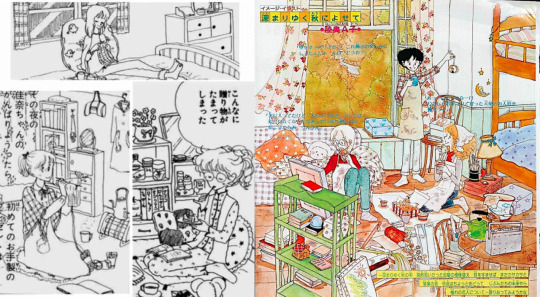
Girls often dreamed with having Western-style bedrooms like the ones in Otometique manga.
While Mutsu A-ko was the trailblazer, she was soon joined at the top by two other iconic artists, Yumiko Tabuchi, and Hideko Tachikake. Each of them had their quirks. Tabuchi, for example, often had college girls as her heroines, mirroring herself as a student at the elite, trendy Waseda University. While Tabuchi and A-ko preferred short stories, Tachikake had a penchant for longer series with a bit more drama. But they all had a similar aesthetic and relied on the charm of ordinary love.
The "otometique" phenomenon reflected the trends of the time and foreshadowed the emerging consumer culture that would swallow the country in the next decade. The sophisticated visuals attracted people of all ages, from elementary school-aged girls to highly educated women and men. Both the top public and private universities in Japan, Tokyo University and Waseda, respectively, had famous "otometique" clubs full of students who loved the genre and the style. The mangas were so trendy that they were often referred to as "Ivy mangas," in reference to the iconic Ivy style that was the catalyst of Japan's youth fashion, which was going through a second revival around that time.
While projecting an atmosphere that girls dreamed of, "otometique" also showcases '70s youth and girls' culture. Melancholic, simple love stories among young people were also the theme of the big folk hits of the time. Ivy or country fashion and long hair for men were the top fashion trends. Western-inspired ideals- in decoration, fashion, and musical taste- were pervasive. And creating subcultures and hobbies around consumption was the path society was taking. Simple life-sized stories as a narrative preference echoed the reality of Japan, which was stabilizing itself after decades of turbulence. These stories brought what the country was craving: comfort.

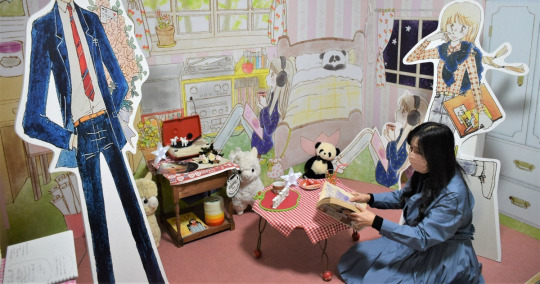
Above, a Mutsu A-ko's bedroom that lived in girls' imagination. Below, the room is recreated in a 2021 exhibition of Ako's art.
Meanwhile, the rise of consumer culture among young girls led to a "fancy goods" boom, with stores selling cute stationery, stickers, and small items popping up everywhere around the country. Illustrators and companies, eager to capitalize, spared no time in creating appealing mascots and drawings to adorn these goods, and it was in that period that Sanrio created Hello Kitty.
Ribon and Nakayoshi, which were "furoku" magazines, also benefitted. Furoku are extra gifts that come with the purchase of the magazines. And the "otometique" boom meant Ribon could include "fancy goods" -- like notebooks, stickers, letter sets, and small paper goods readers could assemble -- with the illustration of these highly sought-after artists. Most girls around Japan could only dream of Western-style rooms, a closet full of cute Ivy fashion, trips to trendy cafes, and homes with French windows. But they could recreate a bit of this sophisticated atmosphere by having letter sets, notebooks, stickers, and small accessories with A-ko Mutsu, Hideko Tachikake, and Yumiko Tabuchi's art. These popular furokus and the "otometique" stories were critical for Ribon magazine to surpass 1 million copies in circulation.
Girls admired A-ko, Tabuchi, and Tachikake not only as artists creating heartfelt stories with attractive atmospheres but as personalities. The trio, who were in their late teens and early 20s, closely resonated with their fans due to their proximity in age and shared interests. The readers were moved when Ribon featured an article in which A-ko Mutsu had the opportunity to meet and interview her favorite singer, the rock star Kenji Sawada, a prominent teen idol of that era. The positive response was so overwhelming that, a few issues later, Hideko Tachikake, an avid folk music enthusiast, also had the chance to interview her idol, Kosetsu Minami, the lead singer of Kaguyahime.
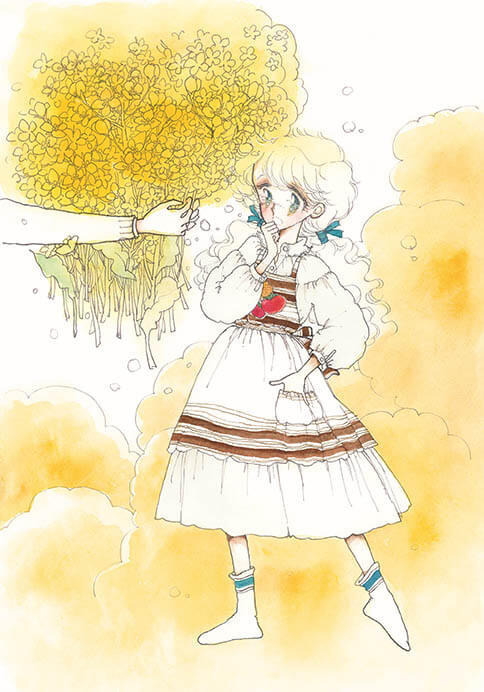
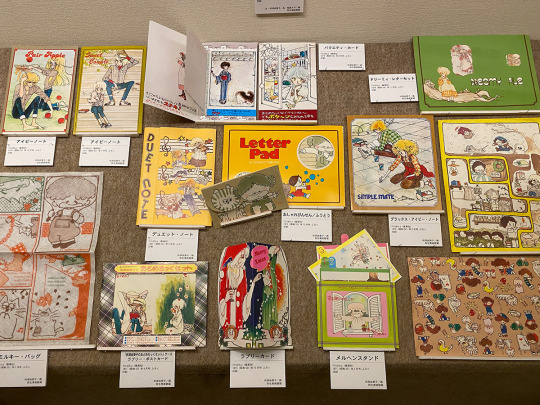
An otometique girl by Yumiko Tabuchi (left) and a collection of furoku illustrated by her as seen on a 2021 exhibition on her art.
The popularity of "otometique" peaked in 1977. By 1981, the boom had almost faded, and A-ko, Tabuchi, and Tachikake published their last works on Ribon in 1985. Tabuchi and Tachikake married and semi-retired, while A-ko successfully transitioned to manga for adult women.
Despite the end of the style, "otometique" permeated every corner of Japanese society. Its furoku and atmosphere were one of the bases for the almighty "kawaii" culture which now rules the country. The life-sized heroines and focus on mundane love stories and everyday emotions went on to become one of the main characteristics of the shoujo manga industry.
The Iwadate Domain
For years, the influence of "otometique" has been downplayed, one of the reasons why the movement is almost undiscussed in the West. However, in the last few years, best-selling books reminiscing the style were published, and exhibitions of A-ko Mutsu and Yumiko Tabuchi's works were big hits across Japan. A-ko, who moved back from Tokyo to her hometown in Fukuoka and never stopped creating manga, was recognized by the local prefecture as an honorary citizen and gained a permanent museum in the area, signaling her importance to the industry.
But while the "otometique" phenomenon happened on the pages of Ribon magazine, Mutsu, Tabuchi, and Tachikake weren't the only three attracting a massive audience to this type of real-life love story.

Mariko Iwadate's work was extremely popular from the late '70s to the mid-2000s. Above, a collection of her work from her Margaret era.
Going back to the research of sociologist Shinji Miyadai, three domains divided '70s shoujo. There was the "Moto Hagio domain," which included the Year 24 artists. The Hagio domain was more highbrow and intellectually challenging, and many considered it an equivalent to literature, attracting the intellectual elite that sniffed at manga in general. It is by far the most discussed and debated '70s shoujo movement, as well as the most famous in the West, but it was the least commercially successful at the time. Then there was the "Machiko Satonaka domain," with emotionally driven stories full of drama, plot twists, and larger-than-life heroines. Most of the '70s best-selling shoujo series fall under this category, which includes the work of Yukari Ichijo and Ryoko Ikeda and sports manga like "Ace wo Nerae," among others.
Finally, there's the domain in which the "otometique" stories were created. And Miyadai doesn't name it after any of the Ribon artists, calling it the "Mariko Iwadate domain" instead.
In the Satonaka domain, the heroine served as a proxy for the reader in a fantastical world, while in the Iwadate domain, the heroine represented the reader in the real world. But, after all, who is the influential Iwadate?
Mariko Iwadate, who made her debut in 1973 at the age of 16, rose to prominence by embracing the "otometique" style during its peak in the late '70s. Similar to Ribon artists, Iwadate, who mostly worked for Weekly Margaret, captivated readers with her elegant and stylish art, featuring cute clothes, accessories, and intricate details.
Miyadai's choice to name the category after Iwadate rather than the genre pioneer A-ko Mutsu may be attributed to Iwadate's sustained success. After leaving Ribon in 1985, A-ko remained prolific and had a dedicated audience, but she couldn't replicate her peak. Iwadate's popularity, on the other hand, continued unabated even after she transitioned to adult women's manga. Iwadate's work, recognized for its emotional depth, became a significant inspiration for trailblazers like best-selling novelist Banana Yoshimoto and avant-garde manga artist Kyoko Okazaki. In 1993, when Miyadai wrote his book, Iwadate's fame and respect probably made her a more recognizable figure for readers to associate with the category.

Iwadate's soft girly art and story-telling made her extremely popular and influential.
Mariko Iwadate's narrative, especially her post-80s work, has a more psychological and mature element to it when compared to Ribon's artists. She, as an artist, bridged the gap between "otometique" and another highly influential "Iwadate domain" artist, Fusako Kuramochi.
Fusako Kuramochi, debuting while still a teen in the early '70s at Bessatsu Margaret (Betsuma), initially emulated her favorite artists, Moto Hagio and Keiko Takemiya, before finding her style—a realistic portrayal of romance with a substantial psychological element. Her success contributed to shaping Betsuma, alongside Ribon, as arguably the most influential and commercially thriving shoujo title -- the go-to magazine for high school rom-com.
Like the otometique artists, Fusako Kuramochi first gained prominence with short stories and one-shots. In 1979, she wrote her first series, "Oshiaberi Kaidan," in which each chapter depicted the life of a young girl from junior high to her graduation day. In 1980, she published "Itsumo poketto ni Chopin," a classical music manga that also dealt with growing up as a teenager in the city. From then on, she'd publish about two hit series every year in Betsuma before graduating successfully to adult women's manga in 1994.
Kuramochi's success was due to her great skill in portraying girls going through crushes, heartbreaks, and jealousy. The psychological elements struck a chord with readers and helped her create male romantic leads that were extremely popular.
Another component of Kuramochi's work was her sophistication, a result of her upbringing. Her father was the chairman of one of Japan's biggest printing companies, and she was raised in Shibuya, in the center of Tokyo, while attending an exclusive all-female institution. The fact she spent her youth in the middle of Tokyo's hustle and bustle meant she knew the capital well, and her works were full of references to trendy cafes, restaurants, nightspots, and neighborhoods. Her Betsuma work was published right before and during Japan's ostentatious Bubble years, so many chasing an exciting city life referred to her work.
While her stories reflected the reality and aspirations of the Bubble years, Kuramochi's true gift lay in providing readers with a realistic depiction of growing up and falling in love, making her work immensely popular. In general, consumerism -- displayed through clothes, accessories, and decor -- isn't as crucial to her success as the three Ribon "otometique" artists.
While Fusako Kuramochi is part of the "Iwadate domain," you can argue that Kuramochi evolved into her own category, which was vital for the development of real-life love stories in shoujo in the '80s and '90s and the rise of other highly-influential artists like Ryo Ikuemi.
But going back to the three '70s movements, "otometique"/"Iwadate domain" was definitely the most influential one in steering shoujo manga in its current direction. On the other hand, all of these domains co-existed together and fed from each other. In 1977, during the "otometique" boom, Yukari Ichijo remained untouched as one of Ribon's most popular artists with her emotionally charged dramas. It was the success of Ichijo and other "Satonaka domain" artists that allowed the "Hagio domain" to debut and take risks. In turn, it was the "Hagio domain" that showed there were rewards for young risk-taking shoujo artists.
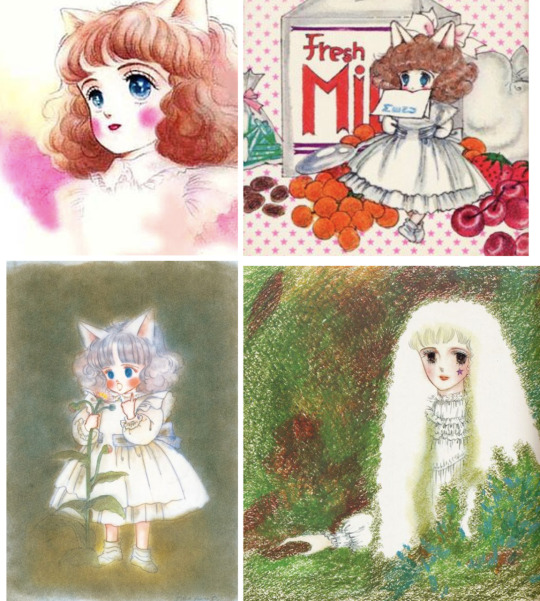
Yumiko Oshima, known for her girly art and sensitive story-telling, is the inspiration behind the otometique boom.
When asked which artist inspired them the most, both A-ko Mutsu and Mariko Iwadate gave the same answer: Yumiko Oshima. Oshima, known for her quirky love stories and girly art, is an artist who trained alongside Hagio and Takemiya at the Oizumi salon and rose as part of the "Year 24 group," publishing risk-taking manga in Shogakukan and Hakusensha's magazine after a brief stint in Weekly Margaret. In other words, despite the striking differences, the origin of the "Iwadate domain" is the "Hagio domain."
While the influence of the idealized real-life romance is the one we can better observe today, contemporary shoujo would not exist if not for all these three styles meshing together and creating something new. And from that, things kept evolving and changing and gaining new forms. Because, once again, manga, and especially shoujo manga, is about reflecting the girly ideals of its time.
#ribon#margaret#go nagai#miki to apple pie#yumiko tabuchi#otometique#otometique manga#mutsu a-ko#mutsu ako#hideko tabuchi#70s japan#fusako kuramochi#betsuma#shoujo manga#vintage shoujo#vintage manga#harenchi gakuen#yumiko igarashi#nakayoshi#yumiko oshima
48 notes
·
View notes
Text



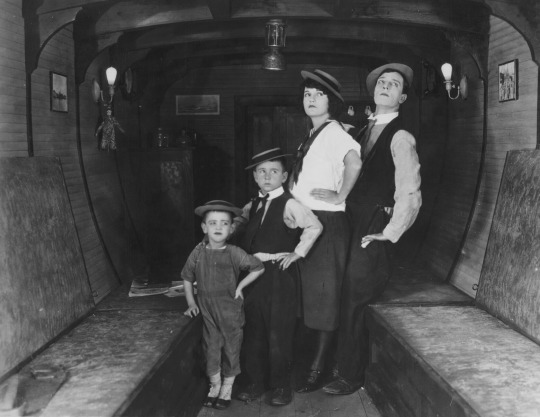



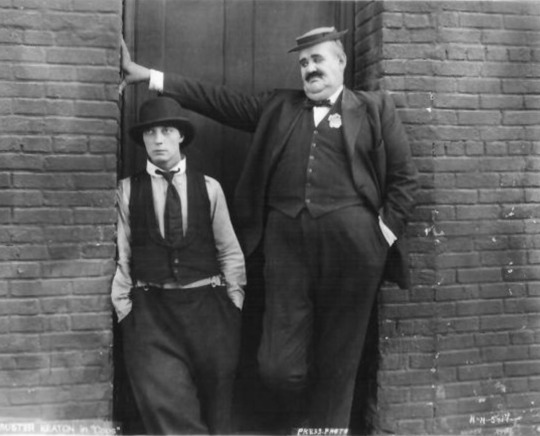

#buster keaton#comedy#silent movies#1920s#silent film#silent comedy#1920s cinema#golden age of hollywood#hollywood#slapstick#big Joe roberts#margaret leahy#Eddie Cline#clyde bruckman#jackie cooper#Paulette dubost#brown eyes#sybil seely#Melissa Talmadge cox#pork pie hat#hat
34 notes
·
View notes
Text
I was wondering at the beginning if he meant rats or criminals but I guess they went with both
Nvm I was wrong...I think?
#p sure margaret knows the meat is#ope nevermind she just said it#wait is it just rats?#though they were making prisoner pie#murdoch mysteries#murdoch mysteries spoilers#mm spoilers
9 notes
·
View notes
Text
Melody: How was the honeymoon?
Margaret: Andy got drunk and tried to destroy our marriage certificate.
Margaret: He said, “good luck trying to return me without the receipt”.
Margaret: I love him.
#the ship should be called apple pie#aaf apple pie#andy the apple#aaf incorrect quotes#aaf#andys apple farm#margaret the mole#melody the moon#andy x margaret#incorrect quotes
22 notes
·
View notes
Text
Me to my cat: aww you're so sweet and so good I love you my little angel
My cat: *steps on the power button of my computer and undoes 45 minutes of persona fusing.
Me: you're so dead. Goodbye.
#easy as pie#pie plays#or do they#maybe he just saved me money i guess#cause i had made a couple of mistakes#and THANKFULLY i saved right before i made trumpeter for margaret#so i dont have to grind levels for her personas#also no cats were harmed in the making of this post#hes not even in trouble really
5 notes
·
View notes
Text
i have an earc of the sapling cage by margaret killjoy (upcoming coming-of-age fantasy novel about a trans girl who joins a coven of witches to learn magic)…i must say i do enjoy having bookseller access to advance copies
#i don't love the formatting of edelweiss but i can get lots of arcs there which is fun#and pie before you see this and shame me i'm sticking to my goal of only having three arcs at a time!!#the sapling cage#margaret killjoy#i read a novella by her a few years ago but am otherwise not super familiar with her work#enjoying tsc so far though!#daughters of the empty throne#bookseller adventures#lulu speaks#lulu reads#lulu reads the sapling cage#lulu reads daughters of the empty throne#books
1 note
·
View note
Text
Title: In Which Gojo Satoru Commits Regicide.
Pairing: Gojo Satoru x Reader (JJK).
Word Count: 0.7k.
TW: Mentions of Consensual Sex and Off-Screen Violence. I Am Coping, But I Am Also Pissed. Be Patient, I Beg of You.
Live Dove: Tender and Sweet.

You’d been a little confused when Satoru came home uncharacteristically giddy in spite of the bitingly cold February weather, and a little more than confused when he said he had something to show you, took you by the arm, and teleported you out of your apartment entirely (after waiting for you to give your clear and enthusiastic consent, of course). You had no idea where he was taking you, but it only took a single second of whipping your head in either direction, a single glimpse of those awful bright yellow curtains and tacky eagle rug, to know where you were.
“Satoru,” you gasped, and his grin widened. “Is this the oval office?”
“The one and only.” His voice was low and smug, his tone more than enough to prove that he already knew you like your surprise. Wrapping an arm around your waist, he swept the content the presidential desk in the floor with his free hand and lifted you onto its outer edge, placing himself in the space between your open legs as if brought there by a gravitational pull. You draped your arms around his neck, pulling him into a long, deep kiss as sweet as apple pie, or funnel cake, or other true symbols of American culture that were formed through a broad, grassroot endearment rather than a bunch of gross old men deciding they’d look cool on a flag three-hundred years ago.
Reminded of gross old men, you pulled away with another sharp gasp. “But, ‘toru, what if he catches us?”
You had no problem with getting your back blown out by your loving boyfriend in one of the most sacred rooms in the United States, but if that lead-paint poisoned geezer happened to walk in (if he even could walk on his own, anymore), it’d totally ruin the mood. Satoru only laughed. “Don’t worry, baby,” And then, flashing you a quick wink, “I made sure to clear the place out for us.”
“Satoru, you didn’t!”
“Guess some fascists just can’t handle their blunt force damage,” he said, shrugging. Suddenly, your expression dropped, and Satoru noticed right away. “What’s wrong, baby?”
“Well, it’s not that the racist, senile felon didn’t deserve to have his skull caved in by a bisexual transgender man – since, y’know, we’re both bisexual and transgender.” Satoru nodded, affirming the fact that you two were similarly transgender and also bisexual, which you were. “It’s just – now that misogynistic white supremacist who jerks off to Margaret Atwood’s The Handmaid’s Tale every night before fucking his couch is going to be president, and that that kind of sucks too.”
“James David Vance?” Satoru asked, refusing to use his initially and therefore highlighting how stupidly pretentious his name was. “You think too little of me, sweetheart.”
Possibly for the third time, you gasped. “Is he…?”
“Mhm. Took care of him right before I came home, got him right as he was coming out of his filler appointment. Beat him to death with a copy of his own book and everything, after leaving it a one-star review on Goodreads, of course.” Again, he shrugged, but smile gave away his self-satisfaction. “It’s all in a day’s work for the world’s strongest and most politically active sorcerer, I guess.”
“But, if that pathetic old man and his castrated lapdog are both dead, then who’s the president?”
“Check the news, baby.”
You fished your phone out of your pocket as Satoru sucked hickeys into your neck, obviously waiting until he had your full attention to go further. Again, you gasped. You were starting to lose count of how many times that’d happened, so far. “Abortions and insulin are provided upon request and also free now?!”
“Oh, wait, are they?” You turned your screen in his direction, and Satoru hummed in approval. Everyone’s quality of life had gotten a lot better since your good friend, Nanami Kento, was placed onto the Supreme Court in the final days of Biden’s term. “Sick. Not what I was talking about, though – scroll down.”
You scrolled down, and gasped once more. Your throat was starting to hurt. “Everyone in the country’s unanimously ellected the first female president?”
“Not just any female president,” he said, smirking and tapping on a trust-worthy article from a reliable and non-partisan source. “Say her name for me, baby.”
The final gasp you gaspt was the loudest and most gasp-like of all.
“Hatsune Miku?!”
#jujutsu kaisen#jujutsu kaisen imagines#jujutsu kaisen x reader#jjk x reader#jjk imagines#gojo satou x reader#gojo x reader#tw politics#tw trump
682 notes
·
View notes
Note
Hey do you have any necromancy items in exchange I will give you this legendary fucker upper.
Looking through the archive and there are surprisingly few items that give you necromancy powers! It seems to just be the Ghost-Filled Antler Flute, the Pie of Necromancy and maybe the Skeleton Throne or the loosely-defined Crime Skeleton. Now if you've already got necromancy powers there's a lot of options, most famously the Bone Bastards and also a few other things, but really what you're gonna want to look at is the #undead tag on RandomEncounters.
If you need an item to give a character/creature necromantic powers, that's easy, just choose literally any mundane item, and slap a skull or bones motif on it, or just google "skull ___" with the slot you want to fill. Here, for example, item: Hat of the Necrocowboy

EDIT: I forgot some people use the word "necromancy" in the older sense of "speak with ghosts" instead of "raise the undead". Let's see...there's a QR code to summon Margaret Thatcher's ghost, the William Castle Patent Ghost Viewer/Remover, and when you're done with them try the Pony of Ghost Busting or the Bicycle version.
And, of course, the Tome of Ghost Seduction.
179 notes
·
View notes
Text
the character of Margaret White is so interesting to me, in both the novel and the book. like the way she keeps giving her daughter chances to "repent", the way shes written as a religious frantic who believes in women being innately sinful, who didn't even know she was giving birth, who (in the film adaptation) had her husband leave her but (in the book) her husband only died, just as crazy as she was, and she keeps his knife. the way shes terrified of carries powers but still tells her to eat her pie. her black cloak. her house covered in religious images and monuments; and how she bumps her feet to music, how she calls the phonograph vic. how, in the book, she and carrie both carry this biblical anger, this violence. how margaret passed it onto carrie, the cycle of mother to daughter that ends with the daughter. how, in the end, carrie's eyes are noted to look exactly like margaret's. shrieking, self-hitting margaret who works at a laundromat and wishes her boss to meet hell. carrie, her daughter, who brings hell to chamberlain -- the same daughter margaret didn't have the will to murder at birth.
something about Margaret White.
51 notes
·
View notes
Text

PASTRY︰SWEET ID PACK

NAMES ⌇ aero. ambrosia. angel. anise. anisette. bakerette. bambi. benedict. berrie. berry. betty. biscuique. blanche. blanchesse. blanchette. bluebell. bonbon. brie. bubblegum. cake. cakerie. cakessa. cakette. cakie. candace. candi. candibelle. candie. candy. caramel. caramella. caramelle. carmella. carmine. cassia. cerise. chantilly. charlotte. cherie. cherry. chiffon. chip. chocco. choco. chocobina. cinna. cinnabelle. cinnabon. cinnamon. claire. clem. clementine. coco. cookie. cookilyn. creamine. creamique. creme. cremelle. crepe. cupcake. cupid. custard. custella. cwake. dahlia. darling. delight. dove. drizzle. dulce. dulcie. eclair. fleur. frostine. fuchsia. graham. gummi. heath. honey. honoré. joy. julienne. kandie. kandy. kat. kit. kitty. lacey. lollie. lollu. lolly. lulu. madeleine. maisie. margaret. marjorie. marshmelle. miel. mielle. mika. millie. mimi. moussette. muffine. nana. nilla. panettiere. pastelle. pastrie. pastrina. patisserie. patty. peach. petal. pippin. pixie. popsy. praline. precious. pudding. puff. puffy. pumpkin. pwuffle. raspberry. reese. rosa. rose. rosie. ruth. rye. sherbet. shortcake. sorbelle. sorbet. sprinkline. strawbette. strawbie. sucre. sucrose. sugar. sugarbelle. sugarlyn. sundae. sundaeya. sunny. sweetheart. sweeti. sweetie. sweets. taffy. tartine. tealyn. teddy. toffee. toffi. trixie. truffrill. tulip. vanilla. vanille. vaniya. wafer. weddicae.

PRONOUNS ⌇ ae/ae. angelsfood/angelsfood. ba/bake. bake/bake. bake/bakery. belle/belle. berry/berry. bite/bite. blush/blush. bon/bon. bow/bow. bread/bread. bun/bun. butter/butter. ca/candy. cae/cake. cake/cake. candy/candy. car/caramel. cara/cara. cara/caramel. ce/cer. che/cher. chef/chef. cherry/cherry. chew/chew. cho/choco. cho/chocolate. choco/choco. choco/chocolate. chocolate/chocolate. cinna/cinna. cinna/cinnamon. cocoa/cocoa. confection/confection. coo/cookie. cookie/cookie. cream/cream. cru/crust. cup/cake. cup/cupcake. cupcake/cupcake. cute/cute. dar/dar. delicacy/delicacy. dessert/dessert. devilsfood/devilsfood. do/donut. doe/donut. dou/dough. dough/dough. fla/flan. flo/flour. fre/fresh. fro/frost. fro/frosting. frost/frost. frosting/frosting. fu/fudge. goodie/goodie. heart/heart. hon/hon. hon/honey. honey/honey. ice/ice. jelly/jelly. lace/lace. lolli/lolli. lolly/lolly. love/love. mac/macaron. mi/mix. mou/mousse. mu/muffin. nom/nom. pas/pastry. pastry/pastry. pi/pixie. pie/pie. pink/pink. plum/plum. pop/pop. puddin/puddin. pudding/pudding. puff/puff. puff/puffle. ro/rose. roll/roll. rose/rose. soft/soft. sprinkle/sprinkle. sti/stix, strawb/strawberry. strawberry/strawberry. su/sucre. su/sugar. sug/sug. sug/sugar. suga/suga. sugar/sugar. swe/sweet. swee/sweet. sweet/sweet. tart/tart. toffee/tofee. trea/treat. treat/treat. wa/warm . 🍡 . 🍦 . 🍧 . 🍩 . 🍪 . 🍫 . 🍬 . 🍭 . 🍮 . 🍯 . 🍰 . 🎂 .

#pupsmail︰id packs#id pack#npt#name suggestions#name ideas#name list#pronoun suggestions#pronoun ideas#pronoun list#neopronouns#nounself#emojiself
89 notes
·
View notes
Text
Andy: So you like cats?
Margaret: Yes, why?
Andy: *tries to impress her by slowly pushing a glass off the table*
Andy: ...Okay, that was dumb.
Margaret: *muffled giggles*
#aaf#aaf incorrect quotes#andys apple farm#andy the apple#margaret the mole#aaf apple pie#andy x margaret#incorrect quotes
18 notes
·
View notes